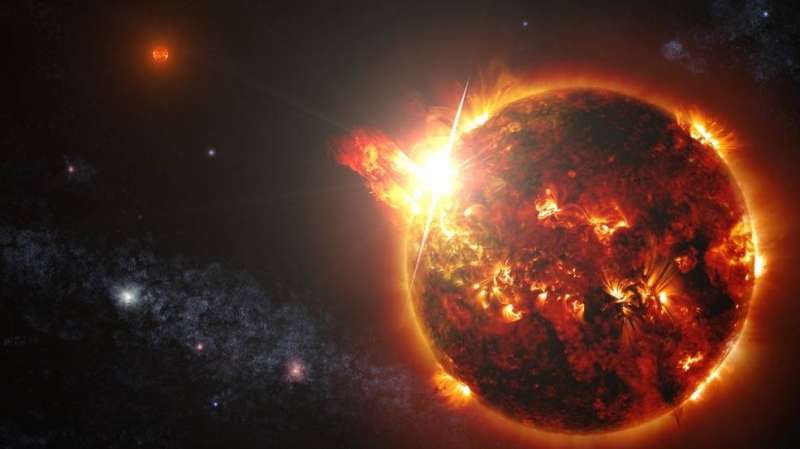April 25, 2018 report
Powerful flare detected on an M-dwarf star

An international team of astronomers reports the finding of ASASSN-18di—a powerful white-light superflare on a previously undetected, mid-type M-dwarf star. The discovery is detailed in a paper published April 12 on the arXiv pre-print repository.
To date, astronomers have observed numerous large flares originating from cool dwarfs. This is due to the fact that M-type and ultracool stars can exhibit high levels of magnetic activity. In general, studying flare events could offer important hints on the properties of magnetic dynamos and interiors of stars; thus, researchers are interested in detecting new flaring activity.
Recently, a group of researchers led by Romy Rodriguez Martinez of the Ohio State University (OSU) has found such a flare on a newly discovered M dwarf. The finding is a result of observations conducted in February 2018 as part of the All-Sky Automated Survey for SuperNovae (ASAS-SN).
"We report the detection of ASASSN-18di, a powerful white-light superflare on a previously undiscovered, mid-type M dwarf located at R.A. 9:58:30.51 and decl. 14:55:39.0," the astronomers wrote in the paper.
As noted in the paper, ASAS-SN is well-suited for the detection of white-light flares. The survey monitors the entire sky on a daily basis and allows astronomers to spot energetic flares on cool dwarfs. The program has already discovered many stellar flares, including two strong ones from an M8 and L1 dwarf.
The star described in the paper has an absolute magnitude of 11.4 and is located approximately 7,200 light years away from the Earth.
According to the study, the flare observed by Martinez's team exhibited a change in an apparent magnitude in the visual (V) band of about 9.8. The researchers assume that the flare was detected near its peak as such change in the magnitude indicates that the flare was not during its rapid impulse or decay phase when observed.
Furthermore, the total energy of the flare was estimated to be about 4.1 undecillion ergs. This value makes ASASSN-18di one of the the strongest flares observed on M dwarfs as well as cool dwarf stars in general.
The astronomers concluded that more intense observations of the newly detected star are needed in order to obtain detailed information about the source. They also added that energetic flares with such change in brightness like ASASSN-18di are very rare, therefore it is unlikely that similar flare will spotted on the same source again.
"Unfortunately, the source presented here is too faint for follow-up characterization without the investment of significant telescope time. In addition, it is unlikely that we will observe another flare of such amplitude, given their low occurrence rate," the scientists noted.
More information: ASASSN-18di: discovery of a ΔV∼10 flare on a mid-M dwarf, arXiv:1804.04673 [astro-ph.SR] arxiv.org/abs/1804.04673
Abstract
We report and characterize a white-light superflare on a previously undiscovered M dwarf detected by the ASAS-SN survey. Employing various color-magnitude and color-spectral type relationships, we estimate several stellar parameters, including the quiescent V-band magnitude, from which we derive a flare amplitude of ΔV∼10. We determine an r-band absolute magnitude of Mr=11.4, consistent with a mid-M dwarf, and an approximate distance to the source of 2.2 kpc. Using classical-flare models, we infer a flare energy of EV≃(4.1±2.2)×1036 ergs, making this one of the strongest flares documented on an M dwarf.
© 2018 Phys.org



















